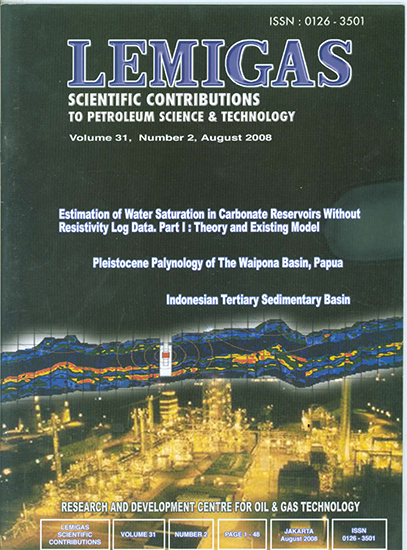PLEISTOCENE PALYNOLOGY OF THE WAIPONA BASIN, PAPUA
DOI:
https://doi.org/10.29017/SCOG.31.2.1001Keywords:
Pleistocene Palynology, Waipona Basin, Papua.Abstract
The Pleistocene sediment from a single well drilled on the back bone of Papua provides good pollen recovery which shows the mixture of the Australian and Asian elements. The well drilled the sediment more than 3000 meter deep which is mostly assigned to Pleistocene age. Only small part of the basal section belongs to Pliocene age. In order to obtain accurate interpretation, the age interpretation is also defined using other disciplines including foraminifera and nannoplankton. The Australian affinity appears as an origin since this island has derived from the Australian continent. On the other hand, the existence of Asian palynomorphs within the studied sediment indicates the dispersal of Asian flora into East Indonesia following the arrival of the Australian plates at about the end of Oligocene. The Asian taxa then migrated to the land mass of New Guinea which rose above sea level from about Middle Miocene onward. In the studied section, shallow marine sediment in the upper interval contains sufficient palynological assemblages which clearly indicate climatic changes from dry or seasonal to wet climate as reflected on the changes of the proportion of dry/ seasonal and wet climate indicators. Unfortunately, due to low pollen recovery, the climate condition of the lower interval can be hardly interpreted. This could have happened because the sediment of the lower interval was deposited in deep marine environment, which was situated far away from the pollen sources in the continent.References
Blow, W. H., 1969. Late Middle Eocene to Recent Planktonic Foraminiferal Biostratigraphy. In Proc. 1st Int. Conf. Plank. Microfossils. pp. 191-422.
Chow, Y. C., 1996. Application of Climatic Biosignals to Stratigraphic Studies Offshore Sabah/ Sarawak, Malaysia. Proceedings of the 9th International Palynological Congress, Houston Texas, June 1996, Abstract, p. 25
Good, R., 1962. On the Geographical Relationships of the Angiosperm Flora of New Guinea. Bulletin of the British Museum (Natural History), Botany 12, pp. 205-226.
Hall, R., 1995. Plate Tectonic Reconstructions of the Indonesian Region. Proceedings 24th Annual Convention, Indonesian Petroleum Association, pp. 71-84.
Hall, R., 1998. The Plate Tectonics of Cenozoic SE Asia and the Distribution of Land and Sea. In: Hall, R. and Holloway, J. (eds.), Biogeography and Geological Evolution in SE Asia. Bukhuys Publishers, Amsterdam, pp. 99-124.
Ingle, J. C. Jr., 1980. Cenozoic Paleobathymetri and Depositional History of Selected Sequences within the Southern California Continental Borderland. Cushman Foundation Special Publication, vol. 19, Memorial to Orville, L. Bandy, pp. 163-195.
Lelono, E. B., Nugrahaningsih, L., Sukmo Rasyanto, T. B., Wijono, S., Rahardjo, A. T. and Polhaupessy, A. A., 1996. Usulan Zonasi Polen 17 PLEISTOCENE PALYNOLOGY OF THE WAIPONA BASIN LEMIGAS SCIENTIFIC CONTRIBUTIONS EKO BUDI LELONO VOL. 31. NO. 2, AUGUST 2008 : 7 - 18 Kawasan Timur Indonesia. Studi Kasus: Sulawesi dan Irian Jaya. Dalam Kumpulan Makalah Seminar Nasional, Peran Sumberdaya Geologi Dalam PJP II, pp. 311- 324.
Lelono, E. B., 2006. Pleistocene Palynology of East Java. Lemigas Scientific Contribution to Petroleum Science and Technology, vol. 29, no. 3, pp. 3-14.
Lemigas. 2006. Biostratigraphic Analyses of Well X Located in Waipona Basin, Indonesia. Unpublished Service Reports.
Martini, E., 1971. Standard Tertiary and Quaternary Calcareous Nannoplankton Zonation in Farinacci, A. (Ed.), Proc. 2nd Plank. Conf. Roma, pp. 739-784. Edizioni Tecnoschienza, Roma.
Morley, R. J., 1995. Biostratigraphic Character ization of System Tracts in Tertiary Sedimentary Basins. Proceedings of the International Symposium on Sequence Stratigraphy in SE. Asia, pp. 49-71.
Morley, R. J., 1977. Floral Zones Applicable to Neogene of Eastern Kalimantan. Unpublished Report. pp. 1-5.
Morley, R. J., 2000. Origin and Evolution of Tropical Rain Forests. Wiley, London.
Rahardjo, A. T., Polhaupessy, A. A., Wiyono, S., Nugrahaningsih, L. and Lelono, E. B., 1994. Zonasi Polen Tersier Pulau Jawa. Proc. IAGI, 23rd Annual Convention.
Tipsword, H. L., Setzer, F.M. and SMITH, F.M. Jr., 1966. Interpretation of Depositional Environment in Gulf Coast Petroleum Exploration from Paleoecology and Related Stratigraphy. Trans. Gulf Coast Ass. Geol. Soc. Vol. XVI. Pp. 119- 130.
Truswell, E. M., Kershaw, A. P. and Sluiter, A. R., 1987. The Australian-Southeast Asia Connection: Evidence from the Paleobotanical Record. In Whitmore, T. C. (ed.), Biogeographical Evolution of the Malay Archipelago. Oxford Monographs on Biogeography 4, Oxford Scientific Publication, pp. 32-49.ˇ
Downloads
Issue
Section
License
Copyright (c) 1970 SCIENTIFIC CONTRIBUTIONS OIL AND GAS (SCOG)

This work is licensed under a Creative Commons Attribution 4.0 International License.
Authors are free to Share — copy and redistribute the material in any medium or format for any purpose, even commercially Adapt — remix, transform, and build upon the material for any purpose, even commercially.
The licensor cannot revoke these freedoms as long as you follow the license terms, under the following terms Attribution — You must give appropriate credit , provide a link to the license, and indicate if changes were made . You may do so in any reasonable manner, but not in any way that suggests the licensor endorses you or your use.
No additional restrictions — You may not apply legal terms or technological measures that legally restrict others from doing anything the license permits.














